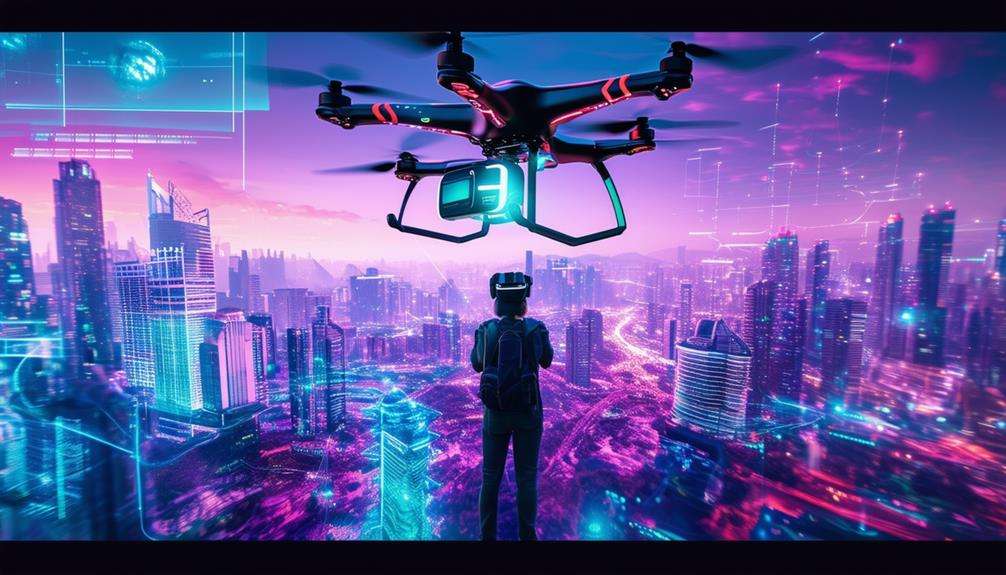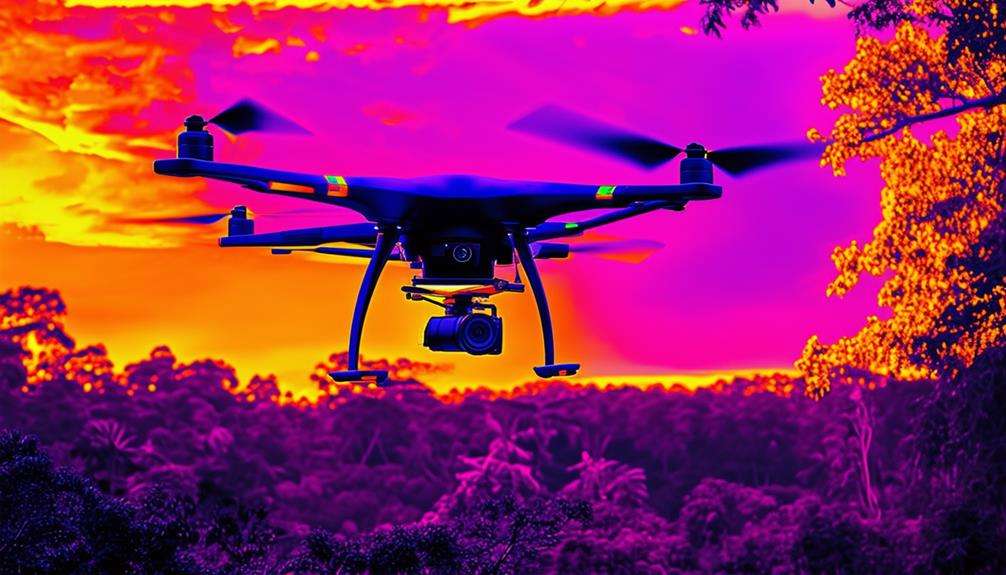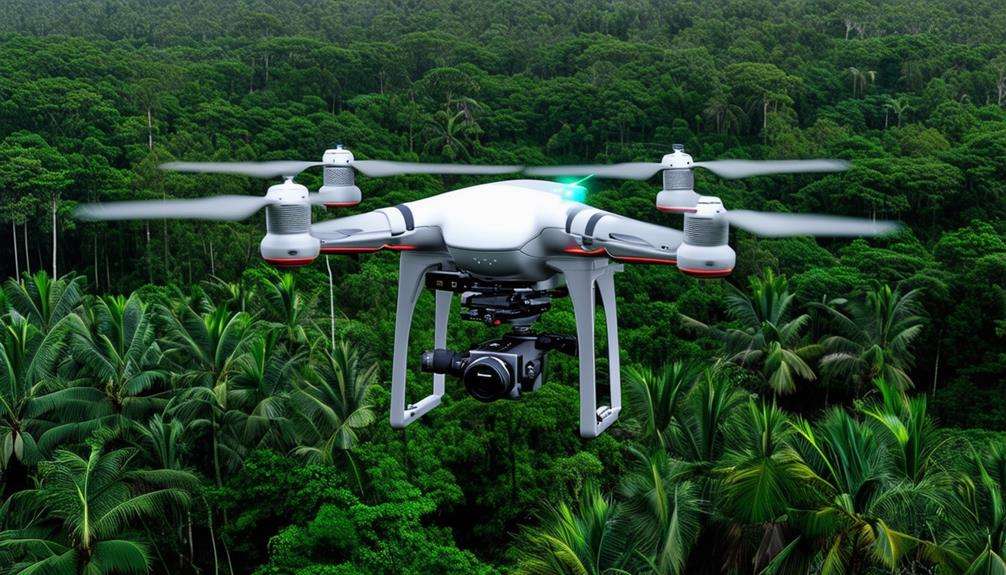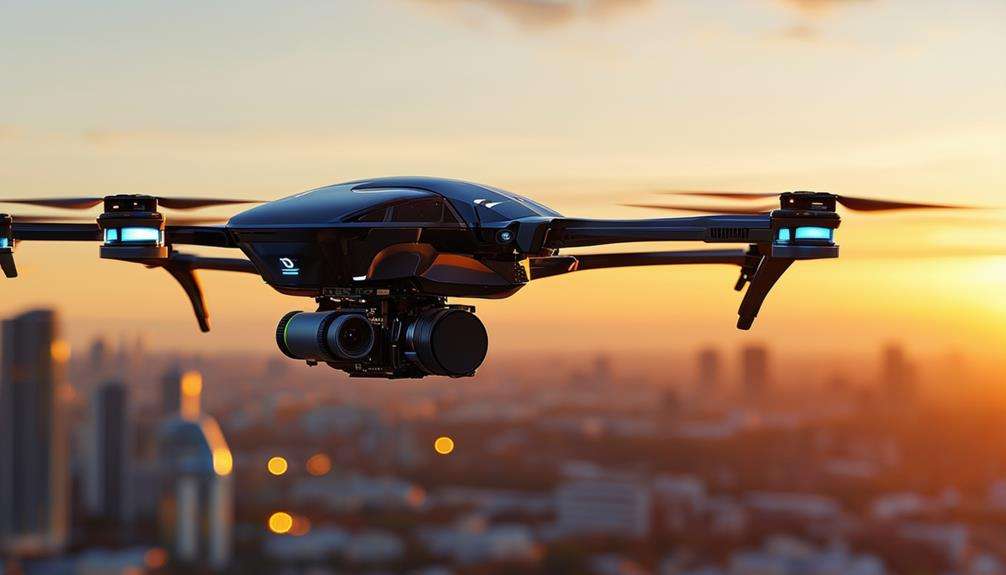The Journey of Drone Innovation: Key Historical Moments
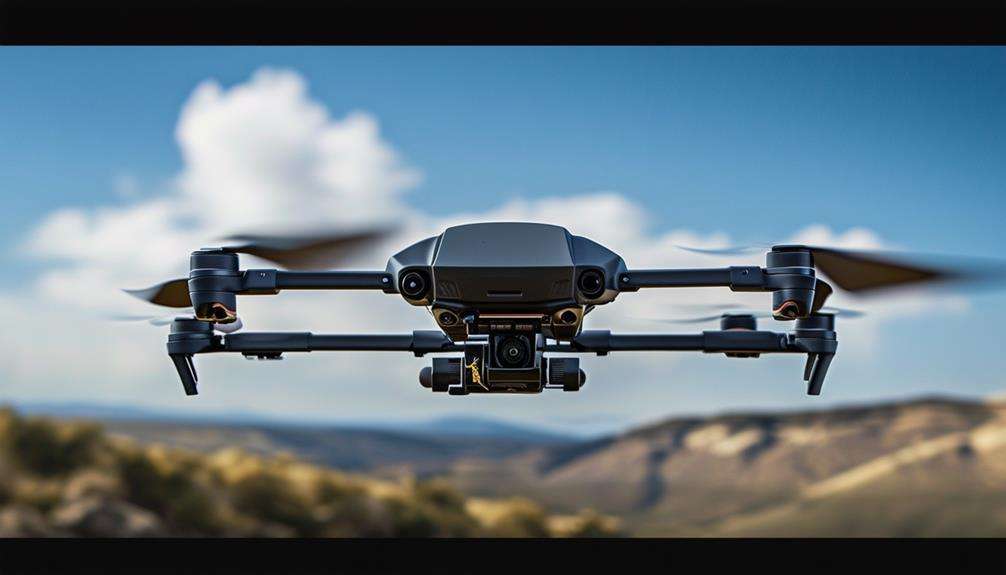
The evolution of drone technology is marked by pivotal moments that have continually expanded the capabilities of unmanned aerial vehicles (UAVs). Starting with hot-air balloon experiments in the 19th century, to their strategic use in World War II and the Cold War, each advancement has contributed to the sophisticated drones we see today.
The transition from military to civilian applications has given rise to commercial drones that revolutionize various industries. Curious about how these milestones have shaped modern sectors and the future prospects of drone technology? Let's explore this intriguing journey.
Early Experiments in the 19th Century
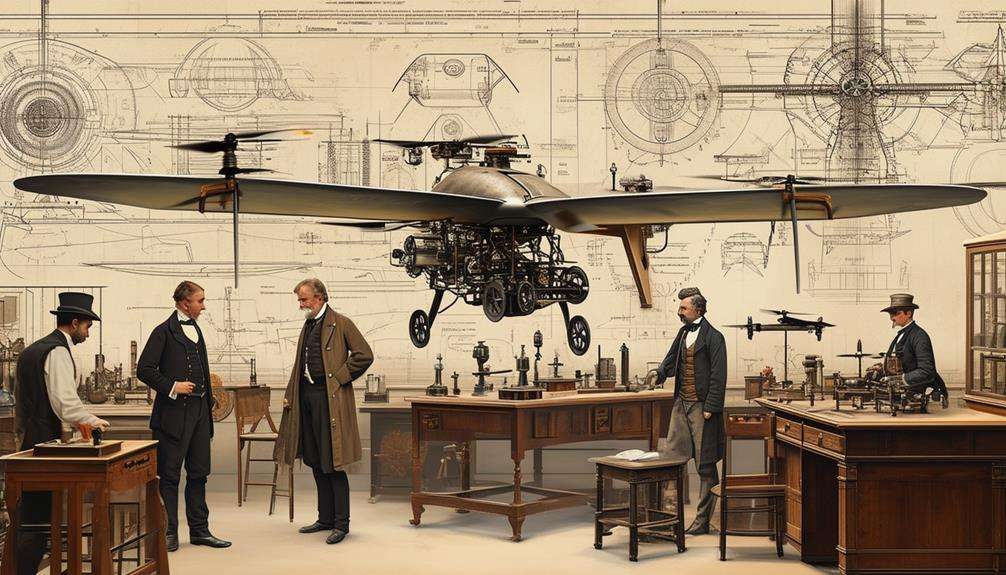
In the 19th century, early experiments in drone technology began with hot-air balloons and evolved into advanced concepts like remote-controlled craft. The initial phase began in 1783 with the first unmanned aerial vehicle (UAV), a simple hot-air balloon, marking the dawn of UAV technology. By 1849, the introduction of military UAVs in the form of balloon bombs highlighted the potential for drone technology in warfare.
In 1858, aerial photography achieved a significant milestone with the first photograph captured from a hot-air balloon, illustrating the potential of UAVs for reconnaissance and documentation. This innovation set a new standard for observing and recording landscapes from the sky.
Fast forward to 1896, Alfred Nobel's rocket-equipped UAV, the first to be fitted with a camera, advanced aerial reconnaissance. This development showcased the integration of cameras into UAVs for strategic purposes.
Just two years later, in 1898, Nikola Tesla demonstrated the first radio-controlled craft, laying the groundwork for remote-controlled UAVs. Tesla's innovation paved the way for future developments in UAV technology, offering a glimpse into the possibilities of remotely piloted flight. These early experiments collectively set the stage for the advanced drone technologies we see today.
The Birth of Military Drones
The birth of military drones began with the development of the De Havilland DH.82B Queen Bee in 1935, marking a significant leap in UAV technology. This drone, often considered the initial modern drone, set the stage for future innovations in military applications. The Queen Bee was primarily used for target practice, allowing military personnel to hone their skills without risking human life.
In 1937, the US Navy advanced the history of drones by developing the Curtiss N2C-2, a radio-controlled UAV torpedo. This early military drone demonstrated the potential for unmanned vehicles in combat scenarios. Meanwhile, actor Reginald Denny contributed to the evolution of military drones by inventing the Radioplane OQ-2 in 1941. This invention further showcased the capabilities of UAVs for military target practice.
| Year | Innovation | Key Figure | Purpose |
|---|---|---|---|
| 1935 | De Havilland DH.82B Queen Bee | De Havilland | Target practice |
| 1937 | Curtiss N2C-2 UAV Torpedo | US Navy | Military applications |
| 1941 | Radioplane OQ-2 | Reginald Denny | Military target practice |
| 1973 | Israeli UAVs | Israel | Surveillance and scouting |
The global adoption of military drones accelerated with Israel's development of UAVs for surveillance in 1973. The introduction of weaponized drones like the Predator in 1996 underscored the profound impact of UAVs on modern warfare. These advancements have since paved the way for the integration of drones in various military operations, from reconnaissance to direct combat roles.
World War II Advancements
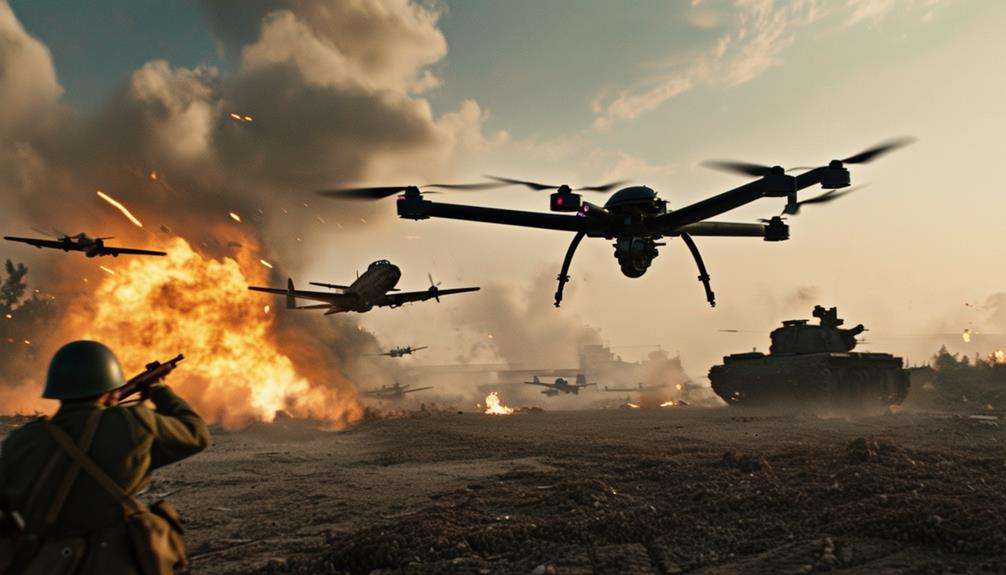
World War II saw significant advancements in drone technology, laying the groundwork for modern UAVs. Several key innovations during this period transformed military applications of drones.
The De Havilland DH.82B Queen Bee, developed in 1935, is considered the first modern drone. It was primarily used for target practice, and its successful test flight in 1936 inspired the United States to initiate their own drone program, marking a shift towards integrating drones into military strategy.
Actor and inventor Reginald Denny played a pivotal role during this period by creating the Radioplane OQ-2 in 1941. These drones were also used for target practice, providing soldiers with realistic training scenarios. Denny's invention significantly increased drone production and underscored their importance in military training.
The BQ-7, introduced in 1943, demonstrated the early use of First-Person View (FPV) technology. This innovation allowed pilots to control drones remotely, adding a new dimension to drone operations.
Key advancements during World War II include:
- Queen Bee (1935): The first modern drone used for target practice.
- Radioplane OQ-2 (1941): Improved military training and increased drone production.
- BQ-7 (1943): Introduced FPV technology for remote control.
These developments set the stage for the future of drone technology.
Cold War Innovations
During the Cold War, rapid advancements in drone technology revolutionized military strategies. One notable innovation was the RQ-2 Pioneer Drone, developed by the US and Israel in 1986. This drone significantly enhanced battlefield UAV capabilities, particularly in surveillance and intelligence gathering.
The 1980s marked a significant increase in drone production, culminating in their vital role during the Gulf War of 1991. Drones like the RQ-2 Pioneer provided around-the-clock surveillance, offering strategic advantages to military operations.
This era also laid the groundwork for future advancements, such as the Predator drone, introduced in 1996. The Predator marked a milestone in weaponized drone technology, enabling precision strikes and real-time reconnaissance. These Cold War innovations paved the way for the widespread use of drones in modern military applications, fundamentally transforming how conflicts are managed and executed.
Drones in the Vietnam War
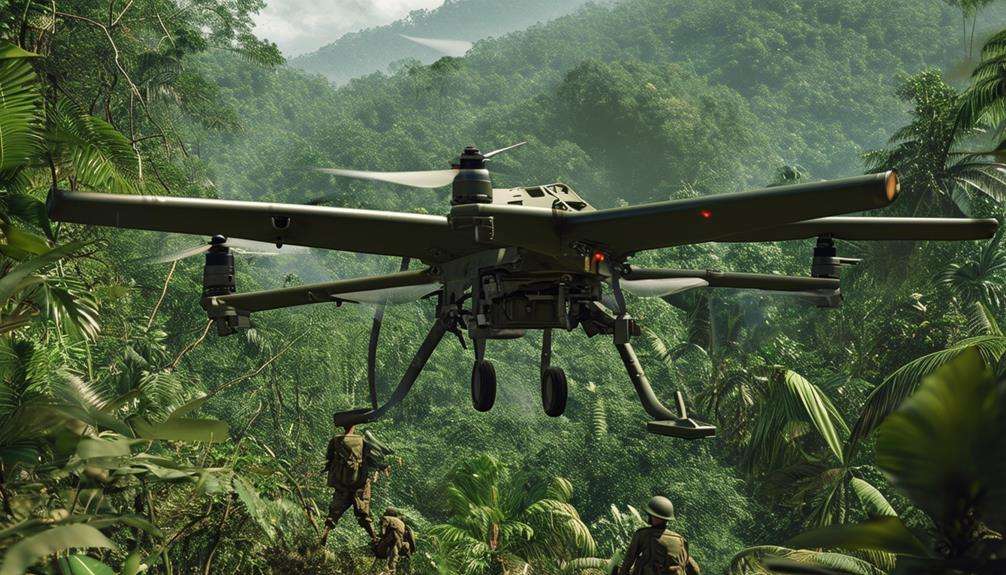
During the Vietnam War, the U.S. military leveraged advancements from the Cold War to deploy drones like the AQM-34N Firebee for critical reconnaissance and intelligence missions. These unmanned aerial vehicles (UAVs) became essential for gathering real-time information, aiding military commanders in making strategic decisions.
Drones played several key roles in the Vietnam War:
- Reconnaissance: The AQM-34N Firebee provided crucial insights into enemy positions, movements, and fortifications, enabling more informed tactical planning.
- Intelligence Gathering: UAVs collected and transmitted data back to command centers, offering an aerial perspective that was otherwise unattainable.
- Combat Support: These drones assisted in target acquisition and surveillance, enhancing the effectiveness of military operations.
The Vietnam War demonstrated the potential of drones in modern warfare. Their ability to perform various military tasks without risking human lives marked a significant shift in combat strategies. The success of the AQM-34N Firebee and other UAVs during this period highlighted the importance of developing and integrating unmanned systems into military operations.
Transition to Civilian Use
The transition to civilian use of drones began gaining momentum in 2006 when the FAA issued the initial commercial permits, unlocking new opportunities for businesses and professionals. This pivotal moment marked the start of a new era where drone technology extended beyond military and recreational applications.
The impact of this transformation is evident in the rapid growth of the commercial drone market. Companies like DJI have revolutionized this space, making drones more accessible and functional across various sectors. Drones aren't only popular among hobbyists but are also becoming essential tools in numerous industries.
Major companies such as FedEx and Amazon are exploring the potential of drone delivery services to enhance their logistics and efficiency. Additionally, the global medical drone market is experiencing significant growth. Drones are used to deliver critical medical supplies to remote or hard-to-reach areas, demonstrating the diverse and vital applications of drone technology.
This period of innovation has spurred investments and advancements, making drones indispensable for civilian use. The issuance of commercial drone permits in 2006 was a game-changer, paving the way for the widespread adoption and integration of drones into everyday life.
Rise of Commercial Drones
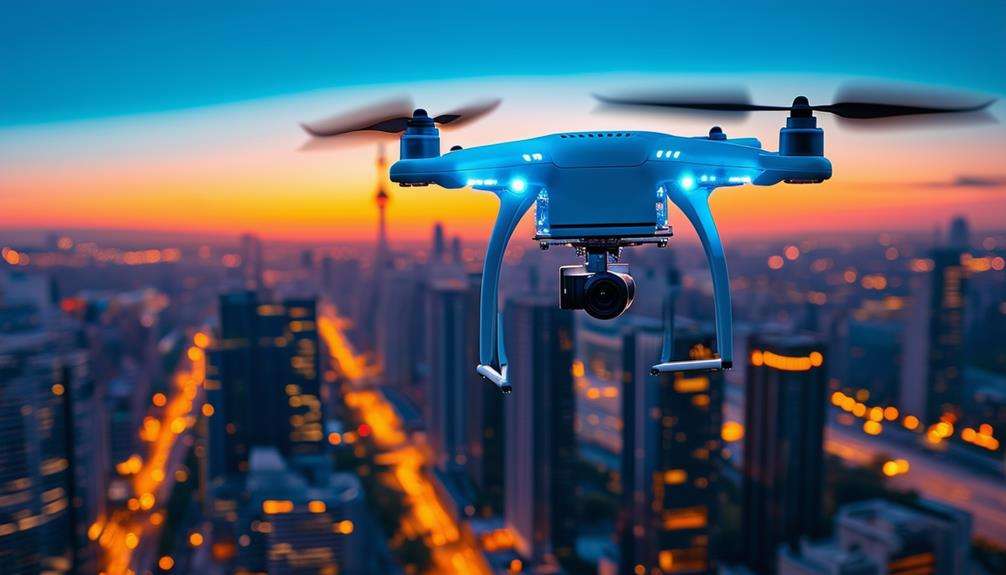
The initial issuance of commercial permits by the FAA in 2006 set the stage for the transformative rise of commercial drones, impacting industries from logistics to healthcare. This regulatory decision facilitated a wide range of non-military applications, fostering rapid innovation. Companies like DJI have been at the forefront of the consumer drone market, democratizing access to drone technology and stimulating further commercial advancements.
Commercial drones have since been integrated into several key sectors:
- Delivery Services: Companies such as FedEx and Amazon are actively developing drone delivery solutions to enhance efficiency and speed.
- Healthcare: The global medical drone market is expanding, with drones being utilized for transporting medical supplies and vaccines to remote areas.
- Investment: Early investments in drone technology during the 1980s and 1990s laid the groundwork for today's advancements, driving growth and diversification across multiple industries.
As commercial drones continue to evolve, their applications proliferate, demonstrating the vast potential of drone technology. This rise isn't merely a technological advancement; it represents a revolution, fundamentally reshaping how industries operate and provide services worldwide.
Drones in Law Enforcement
Drones play a significant role in law enforcement, particularly in surveillance and monitoring. They provide real-time visibility, aiding in traffic management and rapid emergency response. These devices enhance situational awareness, assist in gathering critical evidence, and contribute to maintaining public safety.
Surveillance and Monitoring
The integration of drones into law enforcement has revolutionized surveillance and monitoring, offering real-time visibility and crucial data collection. Aerial surveillance enables law enforcement agencies to monitor expansive areas efficiently. Drones equipped with high-resolution cameras capture detailed images and videos, facilitating various operations, from locating missing persons to gathering vital evidence.
Here are three primary applications of drones in law enforcement:
- Search and Rescue Missions: Infrared-equipped drones can detect individuals hidden from view, significantly enhancing search and rescue efforts.
- Evidence Collection: High-resolution drone cameras provide clear images and videos essential for investigations and legal proceedings.
- Regulatory Compliance: FAA regulations ensure the safe and effective use of drones, mandating proper certification and adherence to operational guidelines.
This technology transcends mere innovation; it enhances the efficiency and effectiveness of law enforcement. Drones provide a bird's-eye view, allowing officers to make real-time decisions based on accurate data. From tracking suspects to assessing accident scenes, drones have become indispensable in modern policing.
Traffic Management Aid
Leveraging the power of real-time aerial views, drones have significantly enhanced traffic management by swiftly identifying accidents, congestion, and road conditions. Law enforcement agencies employ drone technology to reconstruct accidents, manage crowds, and monitor traffic violations. The bird's-eye view provided by UAVs delivers critical data, facilitating more efficient traffic flow and bolstering public safety.
Drones equipped with thermal imaging cameras are invaluable for locating missing persons or suspects in difficult terrains. These capabilities extend beyond simple monitoring, enabling emergency services to respond more quickly and effectively. The real-time monitoring offered by drones allows for rapid situation assessment and resource deployment where they're most needed.
Integrating UAVs into traffic management has streamlined operations and reduced costs. Instead of dispatching multiple patrol cars to investigate an incident, a single drone can cover extensive areas quickly and relay precise information back to the control center. This heightened efficiency enables law enforcement to allocate resources more strategically, improving response times and enhancing public safety. Drones have fundamentally transformed traffic management, making roads safer and law enforcement more proactive.
Future Prospects for Drone Technology
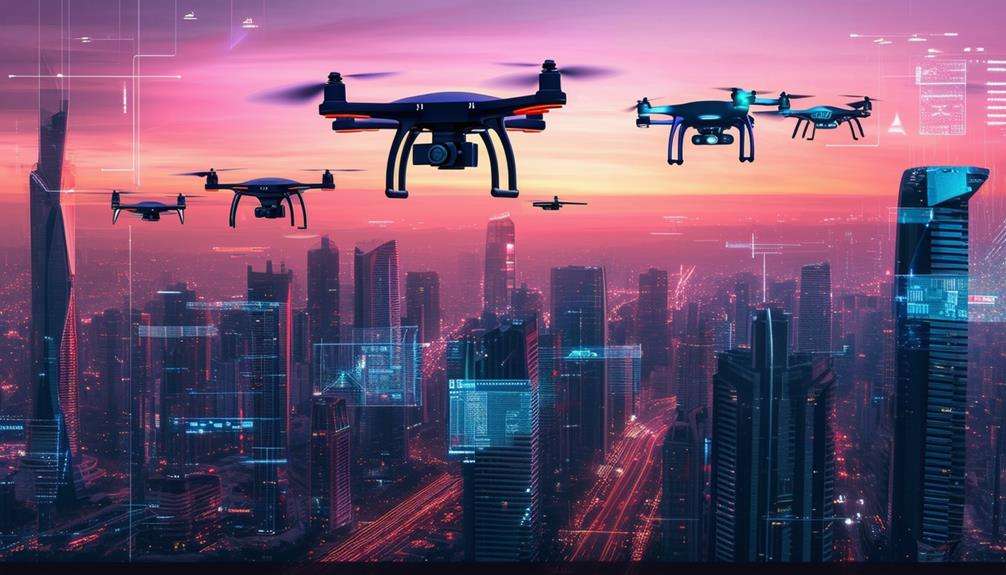
The future of drone technology promises significant advancements, notably in the global medical drone market and the integration of fully autonomous drones. Percepto, a leader in remote inspection and monitoring solutions, has achieved type certification, a crucial step for broader deployment. FAA approval for fully autonomous drones further facilitates large-scale implementation.
Key developments to watch include:
- Global Medical Drone Market Growth: Drones will revolutionize healthcare by delivering medical supplies and providing rapid response capabilities.
- Type Certification Advancements: New certification programs will ensure drones meet safety and regulatory standards, facilitating wider adoption.
- Enhanced Autonomous Capabilities: With FAA approval, fully autonomous drones will become more reliable, offering advanced solutions for critical infrastructure protection and remote monitoring.
Drone technology's future is incredibly promising. Fully autonomous drones, supported by type certification and regulatory approval, will transform industries ranging from healthcare to infrastructure. As these advancements unfold, drones will become integral to diverse sectors.
Conclusion
From 19th-century experiments to military applications and everyday commercial uses, drone innovation has transformed industries and created new opportunities. As drone technology continues to advance, even more exciting prospects lie ahead. Keep an eye on the skies—the story of drones is far from over.

